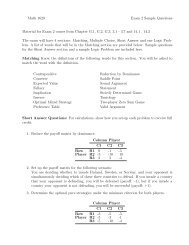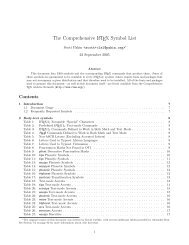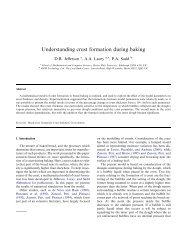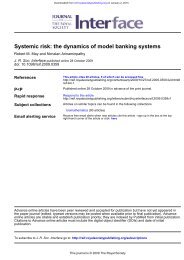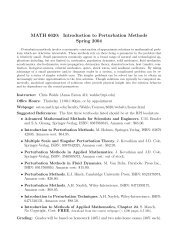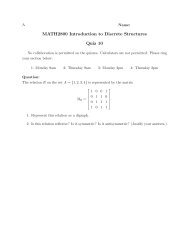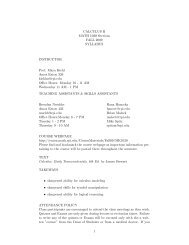On converging shock waves of spherical and polyhedral form
On converging shock waves of spherical and polyhedral form
On converging shock waves of spherical and polyhedral form
Create successful ePaper yourself
Turn your PDF publications into a flip-book with our unique Google optimized e-Paper software.
J. Fluid Mech. (2002), vol. 454, pp. 365–386. c○ 2002 Cambridge University Press<br />
DOI: 10.1017/S0022112001007170 Printed in the United Kingdom<br />
365<br />
<strong>On</strong> <strong>converging</strong> <strong>shock</strong> <strong>waves</strong> <strong>of</strong> <strong>spherical</strong> <strong>and</strong><br />
<strong>polyhedral</strong> <strong>form</strong><br />
By D O N A L D W. S C H W E N D E M A N<br />
Department <strong>of</strong> Mathematical Sciences, Rensselaer Polytechnic Institute, Troy, NY 12180, USA<br />
(Received 10 April 2001 <strong>and</strong> in revised <strong>form</strong> 31 July 2001)<br />
The behaviour <strong>of</strong> <strong>converging</strong> <strong>spherical</strong> <strong>shock</strong> <strong>waves</strong> is considered using Whitham’s<br />
theory <strong>of</strong> geometrical <strong>shock</strong> dynamics. An analysis <strong>of</strong> <strong>converging</strong> <strong>shock</strong>s whose initial<br />
shape takes the <strong>form</strong> <strong>of</strong> regular polyhedra is presented. The analysis <strong>of</strong> this problem<br />
is motivated by the earlier work on <strong>converging</strong> cylindrical <strong>shock</strong>s discussed in<br />
Schwendeman & Whitham (1987). In that paper, exact solutions were reported for<br />
<strong>converging</strong> polygonal <strong>shock</strong>s in which the initial shape re-<strong>form</strong>s repeatedly as the<br />
<strong>shock</strong> contracts. For the <strong>polyhedral</strong> case, the analysis is per<strong>form</strong>ed both analytically<br />
<strong>and</strong> numerically for an equivalent problem involving <strong>shock</strong> propagation in a <strong>converging</strong><br />
channel with triangular cross-section. It is found that a repeating sequence<br />
<strong>of</strong> <strong>shock</strong> surfaces composed <strong>of</strong> nearly planar pieces develops, although the initial<br />
planar surface does not re-<strong>form</strong>, <strong>and</strong> that the increase in strength <strong>of</strong> the <strong>shock</strong> at<br />
each iterate in the sequence follows the same behaviour as for a <strong>converging</strong> <strong>spherical</strong><br />
<strong>shock</strong> independent <strong>of</strong> the convergence angle <strong>of</strong> the channel. In this sense, the <strong>shock</strong>s<br />
are stable <strong>and</strong> the result is analogous to that found in the two-dimensional case.<br />
A numerical study <strong>of</strong> <strong>converging</strong> <strong>spherical</strong> <strong>shock</strong>s subject to smooth initial perturbations<br />
in strength shows a strong tendency to <strong>form</strong> surfaces composed <strong>of</strong> nearly<br />
planar pieces suggesting that the stability result is fairly general.<br />
1. Introduction<br />
In the original description <strong>of</strong> the theory <strong>of</strong> geometrical <strong>shock</strong> dynamics (Whitham<br />
1957), it was shown that a <strong>converging</strong> cylindrical <strong>shock</strong> wave would be unstable<br />
to small disturbances. As these disturbances grow, discontinuities in Mach number<br />
<strong>and</strong> slope along the leading <strong>shock</strong> front, referred to as ‘<strong>shock</strong>-<strong>shock</strong>s’ in the theory,<br />
would develop. The subsequent behaviour <strong>of</strong> the <strong>converging</strong> <strong>shock</strong> <strong>and</strong> hence the<br />
ultimate question <strong>of</strong> stability was not analysed in Whitham (1957). In a later paper<br />
(Schwendeman & Whitham 1987), it was found that the behaviour <strong>of</strong> <strong>converging</strong><br />
cylindrical <strong>shock</strong> <strong>waves</strong> that take the <strong>form</strong> <strong>of</strong> regular polygons could be analysed<br />
exactly within the theory. Each vertex <strong>of</strong> the polygon opens up to <strong>form</strong> a Mach stem<br />
which then proceeds to grow <strong>and</strong> consume the incident <strong>shock</strong>s from the neighbouring<br />
sides. If the initial strength <strong>of</strong> the <strong>shock</strong> is uni<strong>form</strong>, then the Mach stems <strong>form</strong>ed at<br />
the vertices grow <strong>and</strong> eventually meet at the same time thus re-<strong>form</strong>ing the polygon<br />
with a contraction in scale <strong>and</strong> an increase in strength. The process repeats, <strong>and</strong> it<br />
was shown that the increase in Mach number at each step behaves according to the<br />
same law as for a <strong>converging</strong> cylindrical <strong>shock</strong> independent <strong>of</strong> the number <strong>of</strong> sides <strong>of</strong><br />
the original polygon. It was concluded that <strong>converging</strong> cylindrical <strong>shock</strong>s are stable<br />
to perturbations that take the <strong>form</strong> <strong>of</strong> regular polygons.<br />
Numerical calculations <strong>of</strong> the behaviour <strong>of</strong> <strong>converging</strong> cylindrical <strong>shock</strong>s subject
366 D. W. Schwendeman<br />
to smooth perturbations were also presented in Schwendeman & Whitham (1987),<br />
<strong>and</strong> these results showed that <strong>converging</strong> <strong>shock</strong>s have a strong tendency to <strong>form</strong><br />
planar sides <strong>and</strong> polygonal <strong>shock</strong> shapes. A similar behaviour has been observed<br />
experimentally by Takayama, Kleine & Grönig (1987) <strong>and</strong> by Watanabe & Takayama<br />
(1991). In the latter paper, simulations <strong>of</strong> the full equations <strong>of</strong> gasdynamics were<br />
conducted <strong>and</strong> shown to agree with the experimental observations. Thus, the stability<br />
result for regular polygons appears to be fairly general.<br />
Brief comments were made in Schwendeman & Whitham (1987) concerning the<br />
behaviour <strong>of</strong> <strong>converging</strong> <strong>spherical</strong> <strong>shock</strong>s. For initial <strong>shock</strong> shapes that take the <strong>form</strong><br />
<strong>of</strong> regular polyhedra, each vertex <strong>and</strong> edge would <strong>form</strong> a Mach face similar to that for<br />
the cylindrical case. However, an exact solution for the <strong>spherical</strong> case was not found<br />
nor was a detailed analysis given. It was conjectured that the original <strong>polyhedral</strong><br />
shape would not repeat but, rather, more <strong>and</strong> more Mach faces would develop<br />
leading to a closer approximation <strong>of</strong> a sphere <strong>and</strong> stability. In Schwendeman (1993),<br />
a numerical scheme for <strong>shock</strong> propagation in two <strong>and</strong> three dimensions was presented.<br />
In this work, the behaviour <strong>of</strong> <strong>converging</strong> <strong>shock</strong>s in three dimensions, among other<br />
problems, was considered. It was found that smooth, three-dimensional perturbations<br />
<strong>of</strong> <strong>converging</strong> cylindrical <strong>and</strong> <strong>spherical</strong> <strong>shock</strong>s tended to <strong>form</strong> nearly planar Mach<br />
stems similar to that observed in the two-dimensional case. The behaviour <strong>of</strong> an<br />
average fractional change in radius, ∆R/R, for the <strong>converging</strong> <strong>shock</strong>s was calculated<br />
for each case <strong>and</strong> found to decay, thus suggesting stabilty. The <strong>spherical</strong> <strong>shock</strong> case<br />
was considered under the constraint <strong>of</strong> conical guide walls in order to avoid the<br />
geometric singularities at the two poles imposed by a mapping to a Cartesian grid<br />
used in the numerical scheme. The numerical method to be presented here uses an<br />
unstructured grid based on triangular prism cells in part to avoid this difficulty.<br />
Additional studies <strong>of</strong> <strong>converging</strong> <strong>shock</strong>s using geometrical <strong>shock</strong> dynamics have<br />
been discussed in Gardner, Book & Bernstein (1982) following the work in Fong<br />
& Ahlborn (1979). Both <strong>of</strong> these studies concentrated on the behaviour <strong>of</strong> <strong>converging</strong><br />
cylindrical <strong>and</strong> <strong>spherical</strong> <strong>shock</strong>s subject to initial perturbations (possibly large)<br />
that took the shape <strong>of</strong> an isolated bulge. For the <strong>spherical</strong> case, axial symmetry<br />
was assumed. The result was essentially the same as that discussed above. The initial<br />
bulge flattened <strong>and</strong> ultimately <strong>form</strong>ed <strong>shock</strong>-<strong>shock</strong>s <strong>and</strong> planar Mach stem-like<br />
<strong>shock</strong>s in agreement with the observations discussed above. In Apazidis & Lesser<br />
(1996), <strong>converging</strong> <strong>shock</strong>s were generated by reflection from the wall <strong>of</strong> a cylindrical<br />
confinement, <strong>and</strong> polygonal <strong>shock</strong> shapes appeared in cases where the confinement<br />
boundary possessed smooth perturbations about a circular shape.<br />
In this paper, we study the behaviour <strong>and</strong> stability <strong>of</strong> <strong>converging</strong> <strong>spherical</strong> <strong>shock</strong>s.<br />
The analysis is carried out using the approximate theory <strong>of</strong> geometrical <strong>shock</strong> dynamics,<br />
but this theory is believed to be particularly accurate for <strong>converging</strong> <strong>shock</strong>s<br />
in part because <strong>of</strong> the excellent agreement with Guderley’s similarity solution (Guderley<br />
1942) for cylindrical <strong>and</strong> <strong>spherical</strong> <strong>shock</strong>s (see Whitham 1974). We begin by<br />
re-examining the case <strong>of</strong> <strong>converging</strong> <strong>spherical</strong> <strong>shock</strong>s whose initial shape takes the<br />
<strong>form</strong> <strong>of</strong> regular polyhedra. An analysis <strong>of</strong> the propagation <strong>of</strong> these initial <strong>shock</strong><br />
shapes is per<strong>form</strong>ed <strong>and</strong> the results are presented in § 2. It is found that, while it<br />
is possible for the initial <strong>shock</strong> to <strong>form</strong> another regular <strong>polyhedral</strong> shape at a later<br />
stage, it is not possible for the original <strong>polyhedral</strong> shape to re-<strong>form</strong> in a manner<br />
similar to the exact solution worked out for the two-dimensional case. This result,<br />
in agreement with the conjecture in Schwendeman & Whitham (1987), does not<br />
preclude the possibility that an initial <strong>shock</strong> in the shape <strong>of</strong> a regular polyhedron<br />
may propagate <strong>and</strong> evolve into other repeating configurations as it converges. In
<strong>On</strong> <strong>converging</strong> <strong>shock</strong> <strong>waves</strong> 367<br />
(a) (b) (c)<br />
Figure 1. Converging <strong>polyhedral</strong> <strong>shock</strong> with 20 faces initially.<br />
order to examine this possibility, a numerical method <strong>of</strong> calculation is developed in<br />
§ 3, following the work in Schwendeman (1999), <strong>and</strong> is used in § 4 to calculate the<br />
three-dimensional propagation <strong>of</strong> a <strong>shock</strong> in a <strong>converging</strong> channel with a triangular<br />
cross-section. This geometry is motivated by the symmetries present in the regular<br />
polyhedra with 4, 8 <strong>and</strong> 20 faces. It is found that an initially planar <strong>shock</strong> evolves into<br />
a complicated but repeating sequence <strong>of</strong> <strong>shock</strong> surfaces composed <strong>of</strong> nearly planar<br />
pieces connected by <strong>shock</strong>-<strong>shock</strong>s. It is shown that the increase in the <strong>shock</strong> Mach<br />
number for each iterate in the sequence follows the same behaviour as a <strong>converging</strong><br />
<strong>spherical</strong> <strong>shock</strong>, independent <strong>of</strong> the convergence angle <strong>of</strong> the channel. The result is<br />
thus analogous to the stability result in Schwendeman & Whitham (1987) for the<br />
two-dimensional case. Further numerical results are presented in § 5 for <strong>converging</strong><br />
<strong>spherical</strong> <strong>shock</strong>s subject to smooth perturbations in their initial strength. It is found<br />
that the <strong>converging</strong> <strong>shock</strong>s tend to <strong>form</strong> shapes composed <strong>of</strong> (nearly) planar pieces<br />
indicating again that the stability result is fairly general.<br />
2. Converging <strong>polyhedral</strong> <strong>shock</strong> shapes<br />
Regular polyhedra are limited to ones with 4, 6, 8, 12 <strong>and</strong> 20 faces. For example,<br />
consider a <strong>converging</strong> <strong>shock</strong> whose initial shape takes the <strong>form</strong> <strong>of</strong> a regular polyhedron<br />
with 20 faces (an icosahedron) as shown in figure 1(a). As the <strong>shock</strong> collapses, each<br />
vertex <strong>and</strong> edge suffers a Mach reflection to <strong>form</strong> Mach faces as shown in figure 1(b).<br />
(There would also be reflected <strong>shock</strong>s from each <strong>shock</strong>-<strong>shock</strong> edge, but these are<br />
not determined explicitly in geometrical <strong>shock</strong> dynamics.) The <strong>shock</strong> <strong>form</strong>ed at each<br />
vertex has the largest <strong>shock</strong> strength, <strong>and</strong> ultimately consumes the incident <strong>shock</strong>s<br />
from the initial <strong>polyhedral</strong> faces as well as the <strong>shock</strong>s <strong>form</strong>ed by the Mach reflection<br />
from each original edge. If the incident <strong>shock</strong> pieces <strong>and</strong> the <strong>shock</strong>s from the edges<br />
vanish at the same time, then a regular polyhedra with 12 faces (a dodecahedron) is<br />
<strong>form</strong>ed as shown in figure 1(c). The new <strong>polyhedral</strong> <strong>shock</strong>, as indicated in the figure,<br />
would be smaller than the original <strong>and</strong> would have an increased <strong>shock</strong> strength given<br />
by the <strong>converging</strong> <strong>shock</strong>s originating at each vertex. The condition that the incident<br />
<strong>shock</strong>s <strong>and</strong> the <strong>shock</strong>s from the edges vanish at the same time depends on the relative<br />
rates <strong>of</strong> advance <strong>of</strong> the <strong>shock</strong>-<strong>shock</strong>s from the original edges <strong>and</strong> vertices, <strong>and</strong> this<br />
condition is satisfied only in special cases as will be discussed below. For cases when<br />
this initial scenario occurs, the question becomes whether the <strong>shock</strong> returns in shape<br />
to the original icosahedron with a reduction in scale. A similar process may be
368 D. W. Schwendeman<br />
C<br />
E<br />
V<br />
φ<br />
O<br />
Figure 2. Converging channel geometry.<br />
considered for the regular <strong>polyhedral</strong> pairs with 8 <strong>and</strong> 6 faces <strong>and</strong> with 4 <strong>and</strong> 4 faces.<br />
For the latter pair, the intermediate step would also be a tetrahedron.<br />
For each <strong>of</strong> the three pairs we can identify planes <strong>of</strong> symmetry, <strong>and</strong> these may be<br />
viewed as effective walls within the theory. For the polyhedra with 4, 8 <strong>and</strong> 20 faces,<br />
planes <strong>of</strong> symmetry from each edge to the centre <strong>form</strong> <strong>converging</strong> channels with a<br />
triangular cross-section as shown in figure 2. Points C, E <strong>and</strong> V identify the face<br />
centre, an edge centre, <strong>and</strong> a vertex <strong>of</strong> the triangular face <strong>of</strong> the channel, respectively,<br />
<strong>and</strong> the point O lies at the point <strong>of</strong> convergence. The angle φ is the angle between the<br />
centreline OC <strong>and</strong> the line OV , <strong>and</strong> takes the (approximate) values 70.53 ◦ , 54.74 ◦ <strong>and</strong><br />
37.38 ◦ for polyhedra with 4, 8 <strong>and</strong> 20 faces, respectively. The problem <strong>of</strong> the behaviour<br />
<strong>of</strong> a <strong>converging</strong> <strong>shock</strong> whose initial shape takes the <strong>form</strong> <strong>of</strong> a regular polyhedron<br />
with 4, 8 or 20 faces may now be analysed by considering the propagation <strong>of</strong> an<br />
initially planar <strong>shock</strong> in the <strong>converging</strong> channel shown in the figure.<br />
In order to analyse the evolution <strong>of</strong> the <strong>shock</strong> in the <strong>converging</strong> channel, it is<br />
convenient to consider the behaviour in the cut planes OCE <strong>and</strong> OEV as shown in<br />
figure 3. The planes are orthogonal to each other, but share the line OE so that they<br />
may be unfolded <strong>and</strong> laid flat as is done in the figure. The angles θ <strong>and</strong> ψ determine<br />
the behaviour <strong>of</strong> the <strong>shock</strong> propagation in each cut plane <strong>and</strong> these angles are related<br />
to the convergence angle φ by the <strong>form</strong>ula<br />
tan φ = 2 tan θ =<br />
2 tan ψ<br />
√<br />
3 − tan 2 ψ . (2.1)<br />
The initial planar <strong>shock</strong> is seen in the figure connecting points C <strong>and</strong> E <strong>and</strong> has a<br />
Mach number equal to M 1 , say. It experiences a Mach reflection by the effective wall<br />
OE <strong>and</strong> <strong>form</strong>s a <strong>shock</strong>-<strong>shock</strong> <strong>and</strong> a Mach stem with an increased Mach number M 2 .<br />
The path <strong>of</strong> the <strong>shock</strong>-<strong>shock</strong>s from E (shown by the dotted line in the figure) makes<br />
an angle χ relative to the line OE. The angles θ <strong>and</strong> χ <strong>and</strong> the Mach numbers M 1<br />
<strong>and</strong> M 2 are related by the <strong>shock</strong>-<strong>shock</strong> conditions<br />
tan θ = (M2 2 − M2 1 )1/2 (A 2 1 − A2 2 )1/2<br />
A 2 M 2 + A 1 M 1<br />
, tan χ = A 2<br />
A 1<br />
{ 1 − (M1 /M 2 ) 2<br />
1 − (A 2 /A 1 ) 2 } 1/2<br />
(2.2)
<strong>On</strong> <strong>converging</strong> <strong>shock</strong> <strong>waves</strong> 369<br />
C<br />
O<br />
h<br />
w<br />
S<br />
T<br />
P<br />
M 1<br />
v<br />
M 5<br />
M 2<br />
M 3<br />
M 4 Q<br />
v<br />
n<br />
E<br />
U<br />
R<br />
n<br />
V<br />
Figure 3. Behaviour <strong>of</strong> a <strong>converging</strong> <strong>shock</strong> in the cut planes OCE <strong>and</strong> OEV .<br />
(see Whitham 1974). The ray-tube areas A 1 <strong>and</strong> A 2 are related to M 1 <strong>and</strong> M 2 ,<br />
respectively, by an assumed area–Mach number relation. For the case <strong>of</strong> a <strong>converging</strong><br />
<strong>shock</strong>, the <strong>shock</strong> would become strong so that an appropriate <strong>form</strong> is<br />
A = M −n , (2.3)<br />
where the constant n is related to the ratio <strong>of</strong> specific heats γ for an ideal gas (e.g.<br />
n = 5.0743 when γ = 1.4) according to the area–Mach number relation initially<br />
proposed by Chisnell (1957) following the work <strong>of</strong> Chester (1954). Using (2.3), (2.2)<br />
reduces to<br />
tan θ = (1 − ( ) σ2 ) 1/2 (σ −2n − 1) 1/2<br />
1 − σ<br />
2 1/2<br />
, tan χ =<br />
, (2.4)<br />
1 + σ 1−n σ −2n − 1<br />
so that χ <strong>and</strong> σ = M 1 /M 2 are determined by θ <strong>and</strong> n. The Mach stem <strong>form</strong>ed by the<br />
Mach reflection at E, in turn, produces a Mach reflection at V <strong>and</strong> a Mach stem with<br />
<strong>shock</strong> Mach number M 3 . (The dashed line connecting points E <strong>and</strong> V in the figure<br />
indicates the edge along the initial planar <strong>shock</strong> at the wall.) The angle ξ <strong>and</strong> ratio<br />
µ = M 2 /M 3 for this Mach reflection are determined by the angle ψ <strong>and</strong> n using the<br />
<strong>form</strong>ulas<br />
tan ψ = (1 − ( ) µ2 ) 1/2 (µ −2n − 1) 1/2<br />
1 − µ<br />
2 1/2<br />
, tan ξ =<br />
, (2.5)<br />
1 + µ 1−n µ −2n − 1<br />
similar to (2.4).<br />
Top views <strong>of</strong> the corresponding <strong>shock</strong> surfaces are illustrated in figure 4. The initial<br />
planar <strong>shock</strong> shown in figure 4(a) experiences Mach reflections as described above<br />
to become the configuration shown in figure 4(b) composed <strong>of</strong> the incident <strong>shock</strong> in<br />
the centre surrounded by Mach stems from the reflections at the sides <strong>and</strong> corners<br />
<strong>of</strong> the <strong>converging</strong> channel. (The <strong>shock</strong> surfaces decrease in size but this is not shown<br />
in the figure.) If the <strong>shock</strong>-<strong>shock</strong> paths from E <strong>and</strong> V meet at the same time, then
370 D. W. Schwendeman<br />
(a) (b) (c)<br />
C<br />
E<br />
P<br />
Q<br />
V<br />
R<br />
(d)<br />
(e)<br />
S<br />
T<br />
Figure 4. Top view <strong>of</strong> the successive <strong>shock</strong> surfaces in a <strong>converging</strong> channel corresponding to the<br />
construction in the cut planes shown in figure 3. (The contraction in scale is not shown in the<br />
figure.) The arrows indicate the direction <strong>of</strong> propagation <strong>of</strong> the <strong>shock</strong>-<strong>shock</strong>s.<br />
U<br />
the <strong>shock</strong> surface shown in figure 4(c) results. This configuration would correspond<br />
to the <strong>form</strong>ation <strong>of</strong> a dodecahedron as described in figure 1 for the case when the<br />
convergence angle φ is 37.38 ◦ , or to regular polyhedra with 6 or 4 faces when φ<br />
equals 54.74 ◦ or 70.53 ◦ , respectively.<br />
The condition for the incident <strong>shock</strong> to vanish at the point P shown in figure 4(c)<br />
can be worked out from the geometry <strong>of</strong> the <strong>shock</strong>-<strong>shock</strong> paths in figure 3 <strong>and</strong> (2.4)<br />
<strong>and</strong> (2.5) for the angles χ <strong>and</strong> ξ. The distance |OQ| in figure 3 can be determined in two<br />
ways. Let R 1 <strong>and</strong> R 2 denote the distance |OQ| according to the geometry in the planes<br />
OCE <strong>and</strong> OEV , respectively. A straightforward application <strong>of</strong> trigonometry gives<br />
(<br />
R 1 =<br />
tan χ<br />
tan θ + tan χ<br />
)<br />
|OE|, R 2 =<br />
( sec 2 ψ tan ξ<br />
tan ψ + tan ξ<br />
)<br />
|OE|.<br />
The values <strong>of</strong> R 1 <strong>and</strong> R 2 must be equal for the configuration in figure 4(c) to occur.<br />
The <strong>shock</strong>-<strong>shock</strong> <strong>form</strong>ulas (2.4) <strong>and</strong> (2.5) give the angles χ <strong>and</strong> ξ implicitly in terms<br />
<strong>of</strong> θ <strong>and</strong> ψ, respectively, <strong>and</strong> in terms <strong>of</strong> the exponent n in the area–Mach number<br />
relation (2.3). The angles θ <strong>and</strong> ψ, in turn, are related to φ by the geometric <strong>form</strong>ula<br />
(2.1) so that the ratio R 1 /R 2 depends on φ <strong>and</strong> n alone. In figure 5, we plot the ratio<br />
R 1 /R 2 as a function <strong>of</strong> φ for integer values <strong>of</strong> n between 1 <strong>and</strong> 7. As may be seen<br />
from the curves, there is a unique value <strong>of</strong> φ for a given value <strong>of</strong> n for which the ratio<br />
is 1 <strong>and</strong> the configuration in figure 4(c) occurs. The values <strong>of</strong> φ with R 1 /R 2 = 1 range<br />
between 0 as n → 0 <strong>and</strong> 70.53 ◦ as n → ∞. The collapse <strong>of</strong> a strong <strong>shock</strong> in the shape<br />
<strong>of</strong> an icosahedron initially to a dodecahedron corresponds to the case φ = 37.38 ◦ <strong>and</strong><br />
would occur when n = 1.185, <strong>and</strong> the collapse <strong>of</strong> a strong <strong>shock</strong> in the shape <strong>of</strong> an<br />
octahedron initially to a hexahedron corresponds to the case φ = 54.74 ◦ <strong>and</strong> would<br />
occur when n = 4.269. The limiting value <strong>of</strong> φ = 70.53 ◦ (n → ∞) corresponds to the<br />
collapse <strong>of</strong> a strong <strong>shock</strong> in the shape <strong>of</strong> a regular tetrahedron initially.
1.6<br />
<strong>On</strong> <strong>converging</strong> <strong>shock</strong> <strong>waves</strong> 371<br />
1.2<br />
n =7<br />
R 1<br />
R 2<br />
0.8<br />
n =1<br />
0.4<br />
0 20 40 60 80<br />
φ (deg.)<br />
Figure 5. Ratio <strong>of</strong> distances R 1 <strong>and</strong> R 2 versus φ for integer values <strong>of</strong> n.<br />
Assuming that φ <strong>and</strong> n are such that the evolution to the configuration in figure 4(c)<br />
occurs, the final step is to consider whether the <strong>shock</strong> returns to a planar shape. Each<br />
<strong>shock</strong>-<strong>shock</strong> edge, such as P Q, <strong>and</strong> the vertex at P opens up to <strong>form</strong> new Mach<br />
faces <strong>and</strong> corresponding <strong>shock</strong>-<strong>shock</strong>s as shown in figure 4(d). The angle <strong>of</strong> the new<br />
<strong>shock</strong>-<strong>shock</strong>s from P relative to the effective wall OP in the cut plane OCE is χ,<br />
<strong>and</strong> the angle <strong>of</strong> the <strong>shock</strong>-<strong>shock</strong> from the edge P Q from the effective wall OQ in<br />
the cut plane OEV is ξ as shown in figure 3. These angles depend only on φ <strong>and</strong><br />
n, <strong>and</strong> are the same ones as those determined implicitly in (2.4) <strong>and</strong> (2.5) with σ<br />
<strong>and</strong> µ replaced by M 4 /M 5 <strong>and</strong> M 3 /M 4 , respectively. The geometry <strong>of</strong> figure 3 is now<br />
completely determined, <strong>and</strong> we see that a return to a planar <strong>shock</strong> would occur if<br />
the path <strong>of</strong> <strong>shock</strong>-<strong>shock</strong>s from Q met at the point U so that the Mach stem at that<br />
point vanished. This condition, however, is not possible according to the geometry<br />
<strong>of</strong> figure 3 (excluding the limiting case n → ∞) so that there is always a small Mach<br />
stem at U as shown in the figure. This configuration corresponds to the <strong>shock</strong> surface<br />
shown in figure 4(e).<br />
The analysis <strong>of</strong> a <strong>converging</strong> <strong>shock</strong> whose initial shape takes the <strong>form</strong> <strong>of</strong> a regular<br />
polyhedron with 20, 8 or 4 faces has shown that the <strong>shock</strong> may evolve into the shape<br />
<strong>of</strong> a regular polyhedron with 12 or 6 faces at a later time depending on the value<br />
<strong>of</strong> n in the area–Mach number rule (excluding the limiting case n → ∞). However,<br />
the analysis also shows that it is not possible for the <strong>shock</strong> to return in shape to<br />
its original regular <strong>polyhedral</strong> configuration (with reduced size). While it is possible<br />
to pursue the evolution <strong>of</strong> other (non-regular) <strong>polyhedral</strong> <strong>shock</strong> shapes analytically,<br />
we turn instead to a numerical approach which will be used to demonstrate that<br />
<strong>converging</strong> <strong>polyhedral</strong> <strong>shock</strong>s do evolve into repeating configurations that are more<br />
complex than the ones considered analytically above. In addition, the numerical<br />
method will be used to study the behaviour <strong>of</strong> <strong>converging</strong> <strong>spherical</strong> <strong>shock</strong>s subject to<br />
smooth initial perturbations.<br />
3. Numerical method for three-dimensional <strong>shock</strong> propagation<br />
In this section, we develop a numerical method which may be used to calculate<br />
the motion <strong>of</strong> a leading <strong>shock</strong> front in three space dimensions as determined by a
372 D. W. Schwendeman<br />
solution <strong>of</strong> the equations <strong>of</strong> geometrical <strong>shock</strong> dynamics. The numerical approach is<br />
based on a finite-volume discretization <strong>of</strong> the conservation <strong>form</strong> <strong>of</strong> the equations <strong>of</strong><br />
geometrical <strong>shock</strong> dynamics, <strong>and</strong> may be considered as an extension <strong>of</strong> the method<br />
developed in Schwendeman (1999) for <strong>shock</strong> propagation in two dimensions. Both<br />
methods are Godunov-type methods (Godunov 1959), <strong>and</strong> compute numerical fluxes<br />
based on the solution <strong>of</strong> a suitable Riemann problem. For the geometries considered<br />
here an unstructured grid based on triangular prism cells is convenient, in contrast<br />
to the methods discussed in Schwendeman (1993) <strong>and</strong> Schwendeman (1999) which<br />
use structured grids. It is also noted that the method developed here is a fixed-grid<br />
(Eulerian) method which has favourable stability <strong>and</strong> accuracy properties compared<br />
to the moving-grid (Lagrangian) method used in Schwendeman (1988).<br />
3.1. Governing equations <strong>and</strong> discretization<br />
The equations <strong>of</strong> geometrical <strong>shock</strong> dynamics in conservation <strong>form</strong> are<br />
( ) M<br />
∇ ·<br />
A ∇α = 0, M = 1 , A = A(M), (3.1)<br />
|∇α|<br />
where the <strong>shock</strong> position x at a time t is given by the surface α(x) = a 0 t (for a<br />
uni<strong>form</strong> ambient sound speed a 0 ) <strong>and</strong> A = A(M) is an assumed area–Mach number<br />
relation such as that given by (2.3) for strong <strong>shock</strong>s (see Whitham 1974). The<br />
partial differential equation for α in (3.1) is nonlinear <strong>and</strong> hyperbolic, assuming that<br />
A ′ (M) < 0, <strong>and</strong> describes disturbances in Mach number <strong>and</strong> <strong>shock</strong>-front normal that<br />
propagate along the <strong>shock</strong> surfaces, which evolve in the direction <strong>of</strong> ∇α. The object<br />
<strong>of</strong> the numerical method is to determine a discrete representation for α(x) throughout<br />
the region <strong>of</strong> interest so that the successive <strong>shock</strong> positions may then be determined<br />
by computing level surfaces <strong>of</strong> α.<br />
Equations (3.1) are to be solved for α in a three-dimensional region Ω (such as the<br />
<strong>converging</strong> channel shown in figure 2). Let the surface S 0 denote the portion <strong>of</strong> the<br />
boundary <strong>of</strong> Ω on which the arrival time for the leading <strong>shock</strong> front <strong>and</strong> its Mach<br />
number are known. These data correspond to prescribing α <strong>and</strong> its normal derivative<br />
on S 0 . For many problems, including the ones considered in this paper, the surface S 0<br />
coincides with the <strong>shock</strong> surface at t = 0 so that α = 0 on S 0 , but this is not essential.<br />
For the purposes <strong>of</strong> our numerical method, we now introduce a one-parameter family<br />
<strong>of</strong> surfaces S(η) that describes the region Ω for 0 η η final with S(0) = S 0 . The<br />
hyperbolic equation for α will be solved numerically by advancing the solution on the<br />
family <strong>of</strong> surfaces S(η) for increasing values <strong>of</strong> the parameter η. It is noted that while<br />
η plays the role <strong>of</strong> time for the numerical method, it is not equal to the actual time<br />
t for a given <strong>shock</strong> front position in general, <strong>and</strong> the chosen surfaces S(η) are not<br />
the <strong>shock</strong> front positions given by the level surfaces α(x) = a 0 t. The exact solution, in<br />
fact, evolves in the direction <strong>of</strong> ∇α as mentioned before.<br />
We may now define a grid Ω h by the family <strong>of</strong> discrete surfaces S h (η), 0 η η final ,<br />
where h denotes a measure <strong>of</strong> the grid spacing. For the geometries considered in this<br />
paper, it is convenient to describe S h (η) by a set <strong>of</strong> triangular elements as shown in<br />
figure 6, where x i (η), i = 1, . . . , N v , 0 η η final , define the paths <strong>of</strong> the vertices <strong>of</strong><br />
the triangular elements. We also define ˜α k (η), k = 1, . . . , N e , to be a set <strong>of</strong> discrete<br />
approximations for α on the surface S h (η). These discrete values are located at edge<br />
centres as shown in figure 6. Lastly, we define ˜F j (η), j = 1, . . . , N c , to be a set <strong>of</strong><br />
discrete approximations for (M/A)∇α · n on the surface S h (η) located at triangle<br />
centres, where the unit surface normal n points in the direction <strong>of</strong> increasing η.<br />
Let us consider an individual triangular element on the surface S h (η) with centre
<strong>On</strong> <strong>converging</strong> <strong>shock</strong> <strong>waves</strong> 373<br />
α~<br />
k (g)<br />
S h (g)<br />
~<br />
F j (g)<br />
x i (g)<br />
S h (g+Dg)<br />
Figure 6. A small portion <strong>of</strong> the unstructured grid on surfaces S h (η) <strong>and</strong> S h (η + ∆η).<br />
index j = j 0 , say, <strong>and</strong> corresponding edge indices k = k 1 , k 2 , <strong>and</strong> k 3 . The triangular<br />
element maps out a triangular prism over an increment ∆η in the parameter η. An<br />
application <strong>of</strong> the divergence theorem to the equation for α in (3.1) for this prism<br />
suggests the conservative discretization<br />
˜F j0 (η + ∆η)a j0 (η + ∆η) = ˜F j0 (η)a j0 (η) −<br />
3∑<br />
˜G kp (η)b kp (η), (3.2)<br />
where a j0 is the surface area <strong>of</strong> the triangular element, b kp is the surface area <strong>of</strong> the<br />
pth side <strong>of</strong> the prism, <strong>and</strong> ˜G kp is a discrete approximation for (M/A)∇α · ν kp on the<br />
pth side with outward unit normal ν kp . The approximations for α on the edges are<br />
advanced using<br />
˜α kp (η + ∆η) = ˜α kp (η) + ũ kp (η)c kp (η), p = 1, 2 <strong>and</strong> 3, (3.3)<br />
where c kp is the distance from the pth edge centre at η to that at η + ∆η, <strong>and</strong> ũ kp<br />
is a discrete approximation for ∇α · τ kp on the pth side with unit tangent vector τ kp<br />
pointing in the direction <strong>of</strong> the path <strong>of</strong> the edge centres. The surface areas a j0 <strong>and</strong> b kp<br />
<strong>and</strong> the distance c kp are computed easily from the geometry <strong>of</strong> the grid <strong>and</strong> a given<br />
choice for the increment ∆η. Values for ˜G kp <strong>and</strong> ũ kp are obtained from the solution <strong>of</strong><br />
a Riemann problem as will be discussed in § 3.2 below. Assuming that these values<br />
can be found, (3.2) <strong>and</strong> (3.3) provide <strong>form</strong>ulas for advancing the discrete sets {˜F j }<br />
<strong>and</strong> {˜α k }, respectively, from S h (η) to S h (η + ∆η). Starting values for {˜F j } <strong>and</strong> {˜α k } are<br />
known on S h (0) from the incoming <strong>shock</strong> data on the surface S 0 .<br />
Before proceeding to a discussion <strong>of</strong> the Riemann problem <strong>and</strong> the calculation <strong>of</strong><br />
˜G kp <strong>and</strong> ũ kp , a constraint on the numerical method is noted. The constraint may be<br />
seen in the problem <strong>of</strong> computing components <strong>of</strong> ∇α from the data {˜F j } <strong>and</strong> {˜α k }.<br />
These values are needed to compute the <strong>shock</strong> Mach number <strong>and</strong> to provide left<br />
<strong>and</strong> right states for the Riemann problem. For example, let us consider again the<br />
triangular element j 0 with edges k 1 , k 2 <strong>and</strong> k 3 , <strong>and</strong> suppose u 0 is the component <strong>of</strong><br />
∇α in the normal direction n j0 <strong>and</strong> v 0 <strong>and</strong> w 0 are components <strong>of</strong> ∇α in the tangent<br />
plane <strong>of</strong> the surface. Second-order-accurate approximations for v 0 <strong>and</strong> w 0 may be<br />
p=1
374 D. W. Schwendeman<br />
computed from the edge values for α by solving the linear equations<br />
h p · (v 0 e v + w 0 e w ) = ˜α kp − ˜α k1 , p = 2 <strong>and</strong> 3,<br />
where h p is the vector from the edge centre k 1 to the edge centre k p , <strong>and</strong> e v <strong>and</strong> e w<br />
are unit vectors in the tangent plane <strong>of</strong> the surface corresponding to the (orthogonal)<br />
directions <strong>of</strong> the components v 0 <strong>and</strong> w 0 , respectively. The definitions <strong>of</strong> ˜F j0 <strong>and</strong> M 0<br />
provide nonlinear equations for u 0 :<br />
˜F j0 =<br />
(<br />
M0<br />
A(M 0 )<br />
)<br />
u 0 , M 0 = (u 2 0 + v 2 0 + w 2 0) −1/2 ,<br />
but these equations are not solvable for all choices <strong>of</strong> v 0 , w 0 , <strong>and</strong> ˜F j0 . For the<br />
area–Mach number relation (2.3), solutions exist for<br />
[ ] −n/2 ( )<br />
1 n + 1<br />
v<br />
˜F j0 < √<br />
n + 1 n (v2 0 + w0)<br />
2 2<br />
<strong>and</strong> u 0 > 0 + w0<br />
2 1/2<br />
. (3.4)<br />
n<br />
The latter inequality is equivalent to the geometric constraint that the characteristic<br />
cone about ∇α cannot become tangent to the grid surface S h (η). This limits the<br />
angle between the <strong>shock</strong> surfaces α(x) = a 0 t as determined by a solution <strong>of</strong> (3.1)<br />
<strong>and</strong> the chosen family <strong>of</strong> surfaces S(η) for the numerical method. This constraint is<br />
analogous to the one discussed previously in Schwendeman (1999). The implication<br />
<strong>of</strong> the constraint for the problems <strong>of</strong> interest for this paper will be discussed in § 4.<br />
3.2. The Riemann problem for geometrical <strong>shock</strong> dynamics<br />
A Riemann problem is solved numerically in the neighbourhood <strong>of</strong> each face <strong>of</strong> the<br />
prism elements in order to obtain approximations for ˜G k <strong>and</strong> ũ k needed in (3.2) <strong>and</strong><br />
(3.3) to advance ˜F j <strong>and</strong> ˜α k , respectively, on the grid. This approach is similar to the one<br />
used in Schwendeman (1999) for two-dimensional <strong>shock</strong> propagation. For geometrical<br />
<strong>shock</strong> dynamics, a suitable Riemann problem for a system <strong>of</strong> first-order hyperbolic<br />
partial differential equations, equivalent to the second-order scalar equation for α in<br />
(3.1), may be introduced <strong>and</strong> solved for the components <strong>of</strong> ∇α. The solution consists<br />
<strong>of</strong> intervals <strong>of</strong> constant ∇α separated by <strong>shock</strong>-<strong>shock</strong>s or <strong>shock</strong>-expansions. (The<br />
term ‘<strong>shock</strong>-expansion’ used in the present discussion refers to smooth, expansiontype<br />
solutions <strong>of</strong> the equations.) For the two-dimensional case, <strong>form</strong>ulas for these<br />
transitions are available in Whitham (1974). The analogous <strong>form</strong>ulas for the threedimensional<br />
case are new <strong>and</strong> are discussed below. A method <strong>of</strong> iteration involving<br />
the <strong>form</strong>ulas for <strong>shock</strong>-<strong>shock</strong>s <strong>and</strong> <strong>shock</strong>-expansions is used to solve the Riemann<br />
problem numerically <strong>and</strong> determine values for ˜G k <strong>and</strong> ũ k .<br />
Let us consider an orthogonal coordinate system (x, y, z) in the neighbourhood <strong>of</strong><br />
a prism face, where x measures distance along the face in the direction <strong>of</strong> increasing<br />
η, y measures distance normal to the face, <strong>and</strong> z measures distance along the face<br />
in the cross-flow direction (perpendicular to the x-direction). Suppose further that<br />
u = (u, v, w) are the components <strong>of</strong> ∇α in the (x, y, z) directions, respectively. In this<br />
local system, the governing equations (3.1) become<br />
∂<br />
∂x<br />
( M<br />
A(M) u )<br />
+ ∂<br />
∂y<br />
( M<br />
A(M) v )<br />
+ ∂ ∂z<br />
<strong>and</strong> M = (u 2 + v 2 + w 2 ) −1/2 , together with the identities<br />
∂v<br />
∂x − ∂u<br />
∂y = 0,<br />
( M<br />
A(M) w )<br />
= 0, (3.5)<br />
∂w<br />
∂x − ∂u = 0. (3.6)<br />
∂z
<strong>On</strong> <strong>converging</strong> <strong>shock</strong> <strong>waves</strong> 375<br />
For the purposes <strong>of</strong> the numerical method, we are interested in solutions <strong>of</strong> (3.5)<br />
<strong>and</strong> (3.6), depending on (x, y) only, subject to piecewise constant data at x = 0. This<br />
Riemann problem is<br />
with<br />
<strong>and</strong><br />
∂<br />
∂x F(u) + ∂ G(u) = 0,<br />
∂y<br />
∂v<br />
∂x − ∂u<br />
∂y = 0,<br />
F(u) =<br />
u(0, y) =<br />
⎫⎪ ⎬<br />
x > 0, |y| < ∞, (3.7)<br />
∂w<br />
∂x = 0, ⎪ ⎭<br />
Mu<br />
Mv<br />
, G(u) =<br />
A(M) A(M) , (3.8)<br />
{<br />
ul for y < 0,<br />
u r for y > 0,<br />
where the data (u l , u r ) are obtained from the components <strong>of</strong> ∇α belonging to neighbouring<br />
triangular grid cells. If the prism face coincides with a wall boundary <strong>of</strong> Ω h ,<br />
then the reflection condition (u l , v l , w l ) = (u r , −v r , w r ) is used to determine the ghost<br />
state outside the boundary.<br />
We note immediately that w(x, y) = w(0, y) from the third equation in (3.7) so that<br />
the solution <strong>of</strong> the Riemann problem develops for x > 0 with a known constant<br />
value for the cross-flow component <strong>of</strong> ∇α on either side <strong>of</strong> y = 0. The third equation<br />
may now be discarded <strong>and</strong> solutions for the remaining two equations sought with<br />
w = constant on either side <strong>of</strong> y = 0. The jump conditions for <strong>shock</strong>-<strong>shock</strong>s (to be<br />
discussed below) shows that G <strong>and</strong> u are continuous at y = 0 for x > 0, <strong>and</strong> these<br />
values are the ones used for ˜G k <strong>and</strong> ũ k in (3.2) <strong>and</strong> (3.3), respectively.<br />
Shock-<strong>shock</strong> solutions <strong>of</strong> (3.7) from an arbitrary state u 1 to a state u 2 satisfy the<br />
jump conditions<br />
U[F(u 2 ) − F(u 1 )] = G(u 2 ) − G(u 1 ), U[v 2 − v 1 ] = −u 2 + u 1 , U[w 2 − w 1 ] = 0,<br />
where U = dy/dx is the slope <strong>of</strong> the path <strong>of</strong> discontinuity. <strong>On</strong>e family <strong>of</strong> solutions<br />
occurs when U = 0. For this case, the jump in w is arbitrary <strong>and</strong> u <strong>and</strong> G(u) are<br />
continuous. This is the jump (a contact discontinuity) at y = 0 as mentioned above.<br />
The other family <strong>of</strong> solutions occurs when U ≠ 0. For this case, w = w 1 = w 2 ,<br />
U = −(u 2 − u 1 )/(v 2 − v 1 ), <strong>and</strong><br />
−(u 2 − u 1 )[F(u 2 ) − F(u 1 )] = (v 2 − v 1 )[G(u 2 ) − G(u 1 )].<br />
This latter equation can be rewritten in the <strong>form</strong><br />
tan(ϑ 2 − ϑ 1 ) = − [(r2 2 − r2 1 )(A2 2 M2 1 r2 1 − A2 1 M2 2 r2 2 )]1/2<br />
A 2 M 1 r1 2 + A (3.9)<br />
1M 2 r2<br />
2<br />
using the definitions <strong>of</strong> F <strong>and</strong> G in (3.8) <strong>and</strong> introducing the polar coordinates<br />
u = r cos ϑ <strong>and</strong> v = r sin ϑ. There is a choice <strong>of</strong> sign for the square root in (3.9).<br />
Assuming that u 1 lies to the left <strong>of</strong> u 2 , we take the minus sign since ϑ decreases with<br />
increasing y for a solution in which the <strong>shock</strong> front propagates into the <strong>shock</strong>-<strong>shock</strong>.<br />
(This choice <strong>of</strong> sign plays the role <strong>of</strong> satisfying an entropy condition.) It is also noted<br />
that (3.9) reduces to the usual <strong>form</strong>ula for <strong>shock</strong>-<strong>shock</strong>s when w = 0.<br />
Shock-expansion solutions <strong>of</strong> (3.7) may be found by first writing the equations in
376 D. W. Schwendeman<br />
characteristic <strong>form</strong>. The third equation is already in characteristic <strong>form</strong>, while a linear<br />
combination <strong>of</strong> the first <strong>and</strong> second equations in (3.7) gives<br />
mF u (u) du<br />
dx + G v(u) dv = 0, (3.10)<br />
dx<br />
which holds on characteristics with slope dy/dx = m, where m is a root <strong>of</strong> the<br />
quadratic<br />
m 2 F u (u) − m(F v (u) + G u (u)) + G v (u) = 0. (3.11)<br />
We now eliminate m from equations (3.10) <strong>and</strong> (3.11), <strong>and</strong> use the definitions <strong>of</strong> F<br />
<strong>and</strong> G in (3.8) to obtain the differential <strong>form</strong><br />
(u 2 + v 2 + w 2 )(du 2 + dv 2 ) = (1 + β 2 )(udu + vdv) 2 , β 2 = − MA′<br />
A , (3.12)<br />
which holds on the two families <strong>of</strong> characteristics. Again, it is convenient to use polar<br />
coordinates, u = r cos ϑ, v = r sin ϑ, so that the differential <strong>form</strong> in (3.12) becomes<br />
dϑ<br />
dr = ± [ β 2 r 2 − w 2<br />
r 2 (r 2 + w 2 )<br />
] 1/2<br />
. (3.13)<br />
For the strong <strong>shock</strong> case, β 2 = n <strong>and</strong> (3.13) may be integrated (keeping in mind that<br />
w is constant) to give<br />
ϑ 2 − ϑ 1 = ±[P (r 2 , w) − P (r 1 , w)], (3.14)<br />
for a <strong>shock</strong>-expansion transition from a state (r 1 , ϑ 1 , w) to (r 2 , ϑ 2 , w). The function<br />
P (r, w) in (3.14) plays the role <strong>of</strong> a Pr<strong>and</strong>tl–Meyer function, <strong>and</strong> is given by<br />
P (r, w) =<br />
√ ( n<br />
2 ln r 2 + n − 1<br />
2n w2 + √ pq )<br />
− 1 ( p 2<br />
n 2 arctan − q 2<br />
2pq<br />
where p 2 = nr 2 − w 2 <strong>and</strong> q 2 = r 2 + w 2 . The choice <strong>of</strong> sign in (3.14) reflects the two<br />
families <strong>of</strong> <strong>shock</strong>-expansion solutions <strong>and</strong> can be made following the condition that<br />
ϑ increases with increasing y for both families.<br />
We now have the necessary <strong>form</strong>ulas available to complete the solution <strong>of</strong> the<br />
Riemann problem. The solution consists <strong>of</strong> constant states in u separated by <strong>shock</strong><strong>shock</strong>s<br />
or <strong>shock</strong>-expansions given by (3.9) <strong>and</strong> (3.14), respectively, with w = w l or w r ,<br />
<strong>and</strong> a contact discontinuity at y = 0 across which w jumps from w l to w r <strong>and</strong> G <strong>and</strong><br />
u are continuous. A numerical method <strong>of</strong> iteration is used to determine the solution<br />
<strong>and</strong> in particular the values <strong>of</strong> G <strong>and</strong> u. The iteration begins with values for each<br />
constant state given by a linearization <strong>of</strong> the equations. Newton’s method is used to<br />
update the values for u iteratively until the values for G <strong>and</strong> u on y = 0 converge<br />
to within a specified tolerance (taken to be 10 −6 ). These values become ˜G k <strong>and</strong> ũ k in<br />
(3.2) <strong>and</strong> (3.3), respectively.<br />
The numerical method described in §§ 3.1 <strong>and</strong> 3.2, essentially a Godunov method,<br />
is first-order accurate if the left <strong>and</strong> right states for the Riemann problem at each<br />
face are taken from the discrete data at neighbouring grid cells alone. Higher-order<br />
methods (for smooth regions <strong>of</strong> the solution) could be obtained by making corrections<br />
to the left <strong>and</strong> right states based on discrete approximations for the gradient <strong>of</strong> u<br />
(see Schwendeman 1999, for example). This is not done here because <strong>of</strong> the added<br />
numerical cost, mainly, <strong>and</strong> because for many <strong>of</strong> the problems computed the solutions<br />
contain regions <strong>of</strong> uni<strong>form</strong> (or nearly uni<strong>form</strong>) u separated by <strong>shock</strong>-<strong>shock</strong>s. We also<br />
note that approximate Riemann solvers could be used but since the problems <strong>of</strong><br />
interest involve collisions <strong>of</strong> <strong>shock</strong>-<strong>shock</strong>s an exact Riemann solver is preferred.<br />
)<br />
,
<strong>On</strong> <strong>converging</strong> <strong>shock</strong> <strong>waves</strong> 377<br />
Finally, we note that the increment in the parameter η is computed according to a<br />
CFL stability condition:<br />
{ }<br />
L k<br />
∆η = C min<br />
,<br />
1kN e ¯m k (ds/dη) k<br />
where L k is the minimum distance between the kth edge centre <strong>and</strong> the two opposing<br />
vertices belonging the left <strong>and</strong> right cells, ¯m k is the maximum in absolute value <strong>of</strong> the<br />
two slopes <strong>of</strong> the characteristics given by the quadratic in (3.11), <strong>and</strong> (ds/dη) k is the<br />
rate <strong>of</strong> increase <strong>of</strong> distance in the x-direction from the kth edge centre with η. The<br />
constant C is taken to be 0.8 for all calculations.<br />
4. Shock propagation in a <strong>converging</strong> channel<br />
We now return to the problem <strong>of</strong> <strong>shock</strong> propagation in a <strong>converging</strong> channel<br />
with triangular cross-section. The geometry <strong>of</strong> the channel, as shown in figure 2, is<br />
described by the convergence angle φ, <strong>and</strong> while the angles 70.53 ◦ , 54.74 ◦ <strong>and</strong> 37.38 ◦<br />
are relevant for the problem <strong>of</strong> a <strong>converging</strong> <strong>shock</strong> whose initial shape takes the <strong>form</strong><br />
<strong>of</strong> regular polyhedra with 4, 8 <strong>and</strong> 20 faces, respectively, we need not be restricted<br />
to these angles alone. In fact, our numerical calculations suggest that the general<br />
behaviour <strong>of</strong> the <strong>converging</strong> <strong>shock</strong> is independent <strong>of</strong> the choice for φ. Calculations<br />
have been made for a wide range <strong>of</strong> angles <strong>and</strong> in all cases considered, it is found that<br />
an initially planar <strong>shock</strong> evolves into repeating configurations whose Mach numbers<br />
increase with decreasing radius according to the same behaviour as for a <strong>converging</strong><br />
<strong>spherical</strong> <strong>shock</strong>. These repeating configurations appear to be the stable ones for the<br />
<strong>converging</strong> channel geometry.<br />
In order to implement the numerical method for the <strong>converging</strong> channel geometry,<br />
we need to make a choice for the family <strong>of</strong> surfaces S(η) on which the solution <strong>of</strong><br />
the governing equations (3.1) will be computed. A simple choice would be a family <strong>of</strong><br />
planar surfaces with normals parallel to the centreline OC evolving from the initial<br />
<strong>shock</strong> surface when η = 0 towards the convergence point O. This choice is adequate<br />
for relatively small values <strong>of</strong> φ (less than about 30 ◦ ) but is not the best choice for<br />
larger angles. For larger values <strong>of</strong> φ, the angle at which the <strong>shock</strong> is turned by the<br />
channel walls is greater so that the angle between ∇α <strong>and</strong> the centreline becomes<br />
large, <strong>and</strong> the constraint given by the inequalities in (3.4) is reached ultimately. A<br />
better choice for S(η) begins with a planar surface at η = 0, so that S(0) coincides<br />
with the initial <strong>shock</strong> surface for convenience as before, but then evolves into a family<br />
<strong>of</strong> <strong>spherical</strong> surfaces <strong>converging</strong> towards O. This choice is used for the calculations<br />
presented in this section <strong>and</strong> is adequate for values <strong>of</strong> φ to about 45 ◦ . Solutions for<br />
<strong>converging</strong> channels with larger values <strong>of</strong> φ are difficult to calculate using a family <strong>of</strong><br />
smooth surfaces due to the large jump in the <strong>shock</strong>-front normals created by Mach<br />
reflections at the channel walls initially <strong>and</strong> later in the interior.<br />
Let us concentrate first on the behaviour <strong>of</strong> a <strong>shock</strong> propagating in a <strong>converging</strong><br />
channel with φ = 20 ◦ . Initially, the <strong>shock</strong> is planar with Mach number equal to 2, <strong>and</strong><br />
it is located at the inlet to the channel where |OV | = 1. A value <strong>of</strong> n = 5.0743 is used<br />
in the area–Mach relation (2.3) corresponding to strong <strong>shock</strong> propagation in air. The<br />
parameters N c , N e <strong>and</strong> N v which describe the resolution <strong>of</strong> the grid are 65 536, 98 688<br />
<strong>and</strong> 33 153, respectively. Figure 7 shows <strong>shock</strong> surfaces in the <strong>converging</strong> channel for<br />
(early) times between 0.118 <strong>and</strong> 0.196 (assuming a unit sound speed for the gas ahead<br />
<strong>of</strong> the <strong>shock</strong>). The surfaces in the figure are shaded according to the local <strong>shock</strong><br />
Mach number with the lighter shades corresponding to higher Mach numbers (larger
378 D. W. Schwendeman<br />
(a) Time = 0.1183 Average radius = 0.7033 (b) Time = 0.1551 Average radius = 0.6182<br />
3.0<br />
3.0<br />
2.8<br />
2.8<br />
Shock Mach number<br />
2.6<br />
2.4<br />
Shock Mach number<br />
2.6<br />
2.4<br />
2.2<br />
2.2<br />
2.0<br />
2.0<br />
(c) Time = 0.1769 Average radius = 0.5653 (d) Time = 0.1958 Average radius = 0.5174<br />
3.0<br />
3.0<br />
2.8<br />
2.8<br />
Shock Mach number<br />
2.6<br />
2.4<br />
Shock Mach number<br />
2.6<br />
2.4<br />
2.2<br />
2.2<br />
2.0<br />
2.0<br />
Figure 7. Shock surfaces in a <strong>converging</strong> channel with φ = 20 ◦ : early behaviour.<br />
0.2<br />
0.1<br />
(a)<br />
P<br />
C<br />
0.04<br />
(b)<br />
0<br />
Q<br />
E<br />
0<br />
0.1<br />
0.04<br />
0.2<br />
0.08<br />
V<br />
0.3 0 0.2 0.4 0.6 0.8 1.0 0 0.1 0.2 0.3<br />
Figure 8. Contours <strong>of</strong> Mach number in the planes OCE <strong>and</strong> OEV for <strong>shock</strong> propagation in a<br />
<strong>converging</strong> channel with φ = 20 ◦ .<br />
<strong>shock</strong> strengths). The grey-scale bar to the right <strong>of</strong> each plot gives the range <strong>of</strong> Mach<br />
numbers for each surface. As the <strong>shock</strong> propagates, its size decreases but each surface<br />
is scaled to its initial size for clarity. The actual size <strong>of</strong> each <strong>shock</strong> surface is indicated<br />
by its average radial distance from the convergence point as listed above each plot. In
<strong>On</strong> <strong>converging</strong> <strong>shock</strong> <strong>waves</strong> 379<br />
order to interpret the behaviour <strong>of</strong> these <strong>shock</strong> surfaces, it is convenient to consider<br />
contours <strong>of</strong> the <strong>shock</strong> Mach number in the cut planes OCE <strong>and</strong> OEV as shown in<br />
Figure 8(a). The surface in figure 7(a) gives a representative view <strong>of</strong> the <strong>shock</strong> after<br />
its initial interaction with the channel walls. The dark central region <strong>of</strong> the surface<br />
is the incident planar <strong>shock</strong> from C <strong>and</strong> the lighter shaded regions surrounding it<br />
are the Mach stems <strong>form</strong>ed from the Mach reflections at E <strong>and</strong> at V as labelled in<br />
figure 8(a). For this choice <strong>of</strong> φ <strong>and</strong> n, the rate <strong>of</strong> advance <strong>of</strong> the <strong>shock</strong>-<strong>shock</strong> from E<br />
is greater than that from V so that the incident <strong>shock</strong> collapses to a point (as shown<br />
in figure 7b) before the Mach stem from E is consumed by the Mach stem from V .<br />
This corresponds to R 1 /R 2 > 1 in figure 5 <strong>and</strong> is in contrast to the behaviour <strong>of</strong> the<br />
<strong>shock</strong> surfaces for the special case R 1 /R 2 = 1 as discussed previously <strong>and</strong> shown in<br />
figure 4. After the collapse <strong>of</strong> the incident <strong>shock</strong>, a new <strong>shock</strong> is <strong>form</strong>ed along the<br />
centreline at P <strong>and</strong> grows to become the surface shown in figure 7(c). This growing<br />
<strong>shock</strong> eventually meets the Mach stems from V (at the point labelled Q in figure 8a)<br />
to <strong>form</strong> the <strong>shock</strong> surface shown in figure 7(d).<br />
The later-time behaviour <strong>of</strong> the <strong>shock</strong> surfaces may be interpreted with the aid <strong>of</strong><br />
figure 8(b), which shows an enlarged view <strong>of</strong> contours <strong>of</strong> <strong>shock</strong> Mach numbers near<br />
the convergence point. This plot gives a first indication <strong>of</strong> a repeating behaviour <strong>of</strong><br />
the propagating <strong>shock</strong>. A portion <strong>of</strong> the plot that repeats is marked by the region<br />
between the dashed curves to the right <strong>and</strong> the left representing the intersection <strong>of</strong><br />
the cut planes <strong>and</strong> the <strong>shock</strong> surfaces at t = 0.292 <strong>and</strong> 0.331, respectively. Upon close<br />
inspection <strong>of</strong> the figure, it may be seen that this section scales down <strong>and</strong> repeats as<br />
the <strong>shock</strong> propagates towards O. Further evidence <strong>of</strong> this repeating behaviour may<br />
be seen in the sequence <strong>of</strong> 12 <strong>shock</strong> surfaces shown in figure 9. The first <strong>shock</strong> surface<br />
in the sequence corresponds to the dashed curve on the right in figure 8(b) while the<br />
last <strong>shock</strong> corresponds to the dashed curve on the left. The behaviour <strong>of</strong> the <strong>shock</strong><br />
may be followed in time through the sequence by using the general rule that lighter<br />
shaded regions having larger <strong>shock</strong> strength consume darker regions with lower<br />
<strong>shock</strong> strength. By the end <strong>of</strong> the sequence, it is noted that the first <strong>shock</strong> surface in<br />
the sequence has re-<strong>form</strong>ed, but with a larger overall strength <strong>and</strong> a reduced size as<br />
indicated by its average radial distance from O. The <strong>shock</strong> surfaces in the sequence are<br />
more complicated than the ones considered in § 2, <strong>and</strong> they have developed non-planar<br />
pieces so that an exact solution would be difficult to construct analytically.<br />
As the <strong>shock</strong> converges, its Mach number increases, <strong>and</strong> it is interesting to compare<br />
the rate <strong>of</strong> increase with that given by a <strong>converging</strong> <strong>spherical</strong> <strong>shock</strong>. In the latter case,<br />
the increase in Mach number with decreasing radius can be worked out using the<br />
area–Mach number relation. The ray-tube area A for a <strong>spherical</strong> <strong>shock</strong> is proportional<br />
to r 2 , where r is the radius, which gives<br />
M ∝ r −2/n<br />
using (2.3) for strong <strong>shock</strong>s. For the case <strong>of</strong> an initially planar <strong>shock</strong> propagating<br />
in a <strong>converging</strong> channel, the increase in Mach number with decreasing radius may<br />
be considered by following the behaviour along rays from the initial <strong>shock</strong> surface<br />
towards the convergence point. In figure 10, we show log-log plots <strong>of</strong> the <strong>shock</strong> Mach<br />
number along rays from the points C, E <strong>and</strong> V as a function <strong>of</strong> r for the cases<br />
φ = 20 ◦ , φ = 30 ◦ <strong>and</strong> φ = 37.38 ◦ . The latter case corresponds to a <strong>converging</strong> <strong>shock</strong><br />
whose initial shape is an icosahedron. The sharp increases in Mach numbers observed<br />
in the plots are caused by Mach reflections at walls or by <strong>shock</strong>-<strong>shock</strong> collisions<br />
(<strong>shock</strong> focusing). The most extreme behaviour is seen along the ray from V . The<br />
dashed lines in the plots have slope equal to −2/n <strong>and</strong> they are in excellent agreement
380 D. W. Schwendeman<br />
(a) Time = 0.2921 Average radius = 0.2378 (b) Time = 0.3021 Average radius = 0.2020<br />
7<br />
7<br />
6<br />
6<br />
Shock Mach number<br />
5<br />
4<br />
Shock Mach number<br />
5<br />
4<br />
3<br />
3<br />
(c) Time = 0.3069 Average radius = 0.1842 (d) Time = 0.3110 Average radius = 0.1679<br />
7<br />
7<br />
6<br />
6<br />
Shock Mach number<br />
5<br />
4<br />
Shock Mach number<br />
5<br />
4<br />
3<br />
3<br />
(e) Time = 0.3147 Average radius = 0.1527 ( f ) Time = 0.3183 Average radius = 0.1376<br />
7<br />
7<br />
6<br />
6<br />
Shock Mach number<br />
5<br />
4<br />
Shock Mach number<br />
5<br />
4<br />
3<br />
3<br />
Figure 9 (a–f ). For caption see facing page.<br />
with the behaviour <strong>of</strong> the local extrema in Mach number along the ray from V . If we<br />
label the Mach number <strong>and</strong> radius at local maxima, say, as M p <strong>and</strong> r p , respectively,<br />
then it is evident from the plots that<br />
M p ∝ r −2/n<br />
p<br />
so that the increase in Mach number for each step <strong>of</strong> the repeating sequence follows
<strong>On</strong> <strong>converging</strong> <strong>shock</strong> <strong>waves</strong> 381<br />
(g) Time = 0.3225 Average radius = 0.1193 (h) Time = 0.3257 Average radius = 0.1045<br />
7<br />
7<br />
6<br />
6<br />
Shock Mach number<br />
5<br />
4<br />
Shock Mach number<br />
5<br />
4<br />
3<br />
3<br />
(i) Time = 0.3277 Average radius = 0.0946 ( j) Time = 0.3293 Average radius = 0.0863<br />
7<br />
7<br />
6<br />
6<br />
Shock Mach number<br />
5<br />
4<br />
Shock Mach number<br />
5<br />
4<br />
3<br />
3<br />
(k) Time = 0.3303 Average radius = 0.0810 (l) Time = 0.3318 Average radius = 0.0732<br />
7<br />
7<br />
6<br />
6<br />
Shock Mach number<br />
5<br />
4<br />
Shock Mach number<br />
5<br />
4<br />
3<br />
3<br />
Figure 9 (g–l). Shock surfaces in a <strong>converging</strong> channel with φ = 20 ◦ : repeating behaviour.<br />
the same behaviour as that for a <strong>converging</strong> <strong>spherical</strong> <strong>shock</strong> independent <strong>of</strong> the choice<br />
<strong>of</strong> φ.<br />
The repeating behaviour observed here is analogous to that found in Schwendeman<br />
& Whitham (1987) for <strong>converging</strong> cylindrical <strong>shock</strong>s. For the two-dimensional case,<br />
an exact solution was found for <strong>converging</strong> <strong>shock</strong>s whose initial shape takes the <strong>form</strong><br />
<strong>of</strong> regular polygons. As the <strong>shock</strong> collapses the initial shape re<strong>form</strong>s repeatedly <strong>and</strong>
382 D. W. Schwendeman<br />
10 2<br />
10 2<br />
(a)<br />
(b)<br />
Shock Mach number<br />
10 1<br />
C<br />
E<br />
V<br />
Shock Mach number<br />
10 1<br />
C<br />
E<br />
V<br />
10 0 10 –3 10 –2 10 –1 10 0<br />
Radial distance<br />
10 0 10 –3 10 –2 10 –1 10 0<br />
Radial distance<br />
10 2<br />
(c)<br />
V<br />
Shock Mach number<br />
10 1<br />
C<br />
E<br />
10 0 10 –3 10 –2 10 –1 10 0<br />
Radial distance<br />
Figure 10. Behaviour <strong>of</strong> the <strong>shock</strong> Mach numbers along rays from the points V , E <strong>and</strong> C for<br />
(a) φ = 20 ◦ , (b) φ = 30 ◦ <strong>and</strong> (c) φ = 37.38 ◦ .<br />
the increase in the <strong>shock</strong> Mach number with r at each step follows the same <strong>form</strong>ula<br />
as for a <strong>converging</strong> circular <strong>shock</strong> independent <strong>of</strong> the number <strong>of</strong> sides <strong>of</strong> the polygon.<br />
There are effective walls implied by the symmetry <strong>of</strong> the initial polygon so that the<br />
exact solution may be reinterpreted as <strong>shock</strong> propagation in a <strong>converging</strong> wedge with<br />
convergence angle ϕ. The geometry <strong>of</strong> the polygon implies ϕ = 2π/N, where N 3<br />
is an integer, but we need not be restricted to these angles for the wedge problem<br />
<strong>and</strong> may consider any angle on (0, π). The result would be the same. An initially<br />
plane <strong>shock</strong> re-<strong>form</strong>s at successive intervals as it propagates in the <strong>converging</strong> wedge<br />
independent <strong>of</strong> the choice for ϕ. We conclude that there is no essential difference<br />
between the two-dimensional case <strong>and</strong> three-dimensional case considered here, except<br />
that the initial planar <strong>shock</strong> does not re-<strong>form</strong> in the repeating sequence for the threedimensional<br />
case <strong>and</strong> the <strong>shock</strong> surfaces are more complicated. Thus, our numerical<br />
calculations suggest that the stability result implied by the exact solution for the<br />
two-dimensional case carries over to the three-dimensional case as well.<br />
5. Converging <strong>spherical</strong> <strong>shock</strong>s<br />
The behaviour <strong>of</strong> <strong>converging</strong> <strong>spherical</strong> <strong>shock</strong>s subject to smooth perturbations in<br />
their initial strength may be considered using the numerical method discussed in § 3.
<strong>On</strong> <strong>converging</strong> <strong>shock</strong> <strong>waves</strong> 383<br />
(a) Time = 0 Average radius =1 (b) Time = 0.3357 Average radius = 0.0316<br />
3.0<br />
2.8<br />
10.0<br />
9.5<br />
9.0<br />
Shock Mach number<br />
2.6<br />
2.4<br />
Shock Mach number<br />
8.5<br />
8.0<br />
7.5<br />
2.2<br />
7.0<br />
6.5<br />
2.0<br />
6.0<br />
10 2<br />
V<br />
(c)<br />
Shock Mach number<br />
10 1<br />
C<br />
E<br />
10 0 10 –3 10 –2 10 –1 10 0<br />
Radial distance<br />
Figure 11. Converging <strong>spherical</strong> <strong>shock</strong> subject to smooth symmetric perturbation: (a) <strong>shock</strong><br />
surface at t = 0, (b) <strong>shock</strong> surface at t = 0.3357, <strong>and</strong> (c) <strong>shock</strong> Mach numbers along rays.<br />
For this case, the initial <strong>shock</strong> surface is assumed to be <strong>spherical</strong>, <strong>and</strong> the equations<br />
are solved numerically on a family <strong>of</strong> <strong>spherical</strong> surfaces S(η) with decreasing radius,<br />
r = e −η , 0 < η < η final . The initial strength <strong>of</strong> the <strong>shock</strong> is described by a specified<br />
Mach number distribution which is taken to be<br />
}<br />
m∑<br />
M(x) = M 0<br />
{1 + ɛ i [exp(−s i φ i (x)) + exp(−s i (π − φ i (x)))] , (5.1)<br />
i=1<br />
where M 0 is a constant (unperturbed) Mach number, m is one half <strong>of</strong> the number <strong>of</strong><br />
smooth ‘bumps’ in the initial distribution, ɛ i <strong>and</strong> s i give the magnitude <strong>and</strong> spread <strong>of</strong><br />
the ith bump, respectively, <strong>and</strong> φ i (x) ∈ [0, π] is the angle between the position vector<br />
x on the surface <strong>of</strong> the initial <strong>spherical</strong> <strong>shock</strong> <strong>and</strong> a chosen vector x i for the centre<br />
<strong>of</strong> the ith bump. The <strong>form</strong> <strong>of</strong> the perturbation given in (5.1) includes a reflectional<br />
symmetry about the origin so that the point <strong>of</strong> convergence is unchanged from the<br />
unperturbed case. Thus, the chosen family <strong>of</strong> surfaces S(η) remains a suitable choice<br />
for the numerical integration as the <strong>shock</strong> collapses.<br />
We consider first a case in which the initial perturbation has the same symmetry<br />
as that for a <strong>converging</strong> <strong>shock</strong> whose initial shape is an icosahedron. For this case,<br />
we set m = 10, ɛ i = 0.1 <strong>and</strong> s i = 4 for i = 1, . . . , 10, <strong>and</strong> take {x i } to be the
384 D. W. Schwendeman<br />
(a) Time = 0.3354 Average radius = 0.0363<br />
10.0<br />
9.5<br />
9.0<br />
10 1<br />
(b)<br />
Shock Mach number<br />
8.5<br />
8.0<br />
7.5<br />
7.0<br />
6.5<br />
6.0<br />
M(t)/M(0)<br />
10 0 10 –2 10 –1 10 0<br />
r(t)/r(0)<br />
Figure 12. Converging <strong>spherical</strong> <strong>shock</strong> subject to a smooth asymmetric perturbation: (a) <strong>shock</strong><br />
surface at t = 0.3354 <strong>and</strong> (b) average <strong>shock</strong> Mach number versus average radius.<br />
positions <strong>of</strong> the 10 face centres <strong>of</strong> the polyhedron in the upper half-hemisphere.<br />
(The reflectional symmetry in (5.1) gives the corresponding perturbations in the lower<br />
half-hemisphere.) Figure 11(a) shows the initial <strong>shock</strong> surface with the prescribed<br />
distribution <strong>of</strong> smooth bumps in Mach number indicated by the lighter shaded spots<br />
on the <strong>spherical</strong> surface. As the <strong>shock</strong> collapses, the smooth perturbations grow<br />
<strong>and</strong> the <strong>shock</strong> surface develops (nearly) planar pieces connected by <strong>shock</strong>-<strong>shock</strong>s. A<br />
representative view <strong>of</strong> this later-time behaviour is given by the <strong>shock</strong> surface shown<br />
in figure 11(b). The behaviour <strong>of</strong> the <strong>shock</strong> Mach number along rays from points<br />
on the initial surface corresponding to the points C, E <strong>and</strong> V for the polyhedron is<br />
shown in figure 11(c). In this plot, it is clear that the smooth perturbation evolves<br />
into the repeating behaviour discussed earlier for the <strong>converging</strong> channel. This plot<br />
provides a strong indication that the repeating solution is the stable one for initial<br />
perturbations that possess the symmetry <strong>of</strong> a regular polyhedron.<br />
As a last case, we consider the behaviour <strong>of</strong> a <strong>converging</strong> <strong>spherical</strong> <strong>shock</strong> subject to<br />
a smooth perturbation without symmetry, except for the reflectional symmetry built<br />
into (5.1). This may be done by choosing arbitrary values for m, {ɛ i }, {s i } <strong>and</strong> {x i } in<br />
(5.1), <strong>and</strong> <strong>of</strong> course there are many possibilities from which to choose. The aim here<br />
is not to give a full picture <strong>of</strong> all possibilities, but rather to simply indicate a trend<br />
in the behaviour. For this purpose, we choose m, {s i } <strong>and</strong> {x i } as in the symmetric<br />
case, but now take r<strong>and</strong>om values for {ɛ i } on the interval [0.0975, 0.125]. For this<br />
choice, the very early behaviour is close to that observed in the symmetric case, but<br />
the symmetry is broken so that the repeating behaviour is not observed at later times.<br />
There is, however, still a trend towards <strong>shock</strong> surfaces composed <strong>of</strong> nearly planar<br />
pieces, similar to that reported in Schwendeman (1993), <strong>and</strong> this is seen in the sample<br />
<strong>shock</strong> surface shown in figure 12(a). In order to examine the behaviour <strong>of</strong> the Mach<br />
number <strong>of</strong> the <strong>converging</strong> <strong>shock</strong>, we compute a discrete approximation to an average<br />
Mach number defined by<br />
¯M(t) = 1 ∫<br />
σ(t)<br />
M dσ, M = 1<br />
|∇α| ,<br />
where the integral is taken over a <strong>shock</strong> surface α(x) = a 0 t for a given time t, <strong>and</strong><br />
σ(t) is the surface area <strong>of</strong> the <strong>shock</strong> at t. In figure 12(b) we plot ¯M(t)/ ¯M(0) versus<br />
¯r(t) = (σ(t)/σ(0)) 1/2 on a log-log scale for t between 0 <strong>and</strong> 0.3383. As can be seen in
<strong>On</strong> <strong>converging</strong> <strong>shock</strong> <strong>waves</strong> 385<br />
the plot, the surface average smooths out the local jumps in Mach number across<br />
<strong>shock</strong>-<strong>shock</strong>s, <strong>and</strong> the rate <strong>of</strong> increase in the average Mach number agrees well with<br />
that given by an unperturbed <strong>converging</strong> <strong>spherical</strong> <strong>shock</strong> (the dashed line with slope<br />
−2/n in the figure).<br />
The implication <strong>of</strong> the calculations in this section is that there is a tendency for<br />
<strong>converging</strong> <strong>shock</strong>s to <strong>form</strong> nearly planar pieces so that the stability result suggested<br />
by the numerical results <strong>of</strong> §4 appears to be general.<br />
6. Conclusions<br />
A study <strong>of</strong> <strong>converging</strong> <strong>spherical</strong> <strong>and</strong> <strong>polyhedral</strong> <strong>shock</strong>s was conducted within the<br />
theory <strong>of</strong> geometrical <strong>shock</strong> dynamics. For the <strong>polyhedral</strong> case, an analytical <strong>and</strong><br />
numerical analysis was carried out for an equivalent problem involving an initially<br />
planar <strong>shock</strong> propagating in a <strong>converging</strong> channel with triangular cross-section.<br />
It was shown that the initial <strong>shock</strong> evolved into a repeating sequence <strong>of</strong> <strong>shock</strong><br />
surfaces consisting <strong>of</strong> nearly planar <strong>shock</strong> pieces connected by <strong>shock</strong>-<strong>shock</strong>s, <strong>and</strong><br />
that the increase in strength <strong>of</strong> the <strong>shock</strong>s followed the same behaviour as that for<br />
a <strong>converging</strong> <strong>spherical</strong> <strong>shock</strong> independent <strong>of</strong> the convergence angle <strong>of</strong> the channel.<br />
It was concluded that this solution is analogous to the exact solution discussed in<br />
Schwendeman & Whitham (1987) for <strong>converging</strong> <strong>shock</strong>s whose initial shape takes the<br />
<strong>form</strong> <strong>of</strong> regular polygons. The fact that the repeating surfaces in the solution for the<br />
<strong>polyhedral</strong> case involve non-planar pieces in contrast to the planar <strong>shock</strong> surfaces in<br />
the exact solution for the polygonal case is not entirely surprising <strong>and</strong> is reminiscent<br />
<strong>of</strong> the difference between the leading <strong>shock</strong> surfaces for conical <strong>and</strong> planar Mach<br />
reflection (see Hornung & Schwendeman 2001, for example). An important implication<br />
suggested by the numerical solution for the <strong>converging</strong> channel is that a <strong>spherical</strong><br />
<strong>shock</strong> is stable to perturbations that take the <strong>form</strong> <strong>of</strong> regular polyhedra. It was noted<br />
in § 4 that this result is an extension <strong>of</strong> the stability result established in the earlier<br />
paper for the cylindrical case.<br />
Numerical results were presented for <strong>converging</strong> <strong>spherical</strong> <strong>shock</strong>s with smooth<br />
initial perturbations in <strong>shock</strong> strength. For a case in which the perturbation possessed<br />
the same symmetry as an icosahedron, it was shown that the solution evolved into<br />
the same repeating sequence as found previously for the corresponding case <strong>of</strong> a<br />
<strong>converging</strong> channel with φ = 37.38 ◦ . This numerical result provides strong evidence<br />
that the repeating solution is the stable one for <strong>converging</strong> <strong>spherical</strong> <strong>shock</strong>s subject<br />
to smooth perturbations with the symmetry <strong>of</strong> regular polyhedra. A second case was<br />
considered in which the perturbation had only a reflectional symmetry so that the<br />
point <strong>of</strong> convergence was unchanged from the unperturbed solution. In this latter<br />
case, it was found that the <strong>shock</strong> developed nearly planar surfaces, <strong>and</strong> an average<br />
<strong>shock</strong> strength was calculated <strong>and</strong> shown to increase at a rate nearly equal to that <strong>of</strong><br />
an unperturbed <strong>converging</strong> <strong>spherical</strong> <strong>shock</strong>. The conclusion supported by both cases<br />
is that <strong>converging</strong> <strong>spherical</strong> <strong>shock</strong>s are stable to smooth initial perturbations in <strong>shock</strong><br />
strength.<br />
Finally, it is noted that the numerical method developed here to compute <strong>converging</strong><br />
<strong>shock</strong>s has a wider range <strong>of</strong> applicability. The method enjoys the flexibility <strong>of</strong> an<br />
unstructured grid <strong>and</strong> may be used to compute three-dimensional <strong>shock</strong> propagation<br />
for a wide variety <strong>of</strong> geometric configurations. In addition, the method could be<br />
extended, following the work in Schwendeman (1999) for example, to h<strong>and</strong>le <strong>shock</strong><br />
propagation in gases with non-uni<strong>form</strong> properties ahead <strong>of</strong> the <strong>shock</strong>.
386 D. W. Schwendeman<br />
REFERENCES<br />
Apazidis, N. & Lesser, M. B. 1996 <strong>On</strong> generation <strong>and</strong> convergence <strong>of</strong> polygonal-shaped <strong>shock</strong><br />
<strong>waves</strong>. J. Fluid Mech. 309, 301–319.<br />
Chester, W. 1954 The quasi-cylindrical <strong>shock</strong> tube. Phil. Mag. 45, 1293–1301.<br />
Chisnell, R. F. 1957 The motion <strong>of</strong> a <strong>shock</strong> wave in a channel, with applications to cylindrical<br />
<strong>and</strong> <strong>spherical</strong> <strong>shock</strong>s. J. Fluid Mech. 2, 286–298.<br />
Fong, K. & Ahlborn, B. 1979 Stability <strong>of</strong> <strong>converging</strong> <strong>shock</strong> <strong>waves</strong>. Phys. Fluids 22, 416–421.<br />
Gardner, J. H., Book, D. L. & Bernstein, I. B. 1982 Stability <strong>of</strong> imploding <strong>shock</strong>s in the CCW<br />
approximation. J. Fluid Mech. 114, 41–58.<br />
Godunov, S. K. 1959 Difference methods for the numerical calculation <strong>of</strong> the equations <strong>of</strong> fluid<br />
dynamics. Mat. Sb. 47, 271–306.<br />
Guderley, G. 1942 Starke kugelige und zylindrische Verdichtungsstösse in der Nähe des Kugelmittelpunktes<br />
bzw der Zylinderachse. Luftfahrtforschung 19, 302–312.<br />
Hornung, H. G. & Schwendeman, D. W. 2001 Oblique <strong>shock</strong> reflection from an axis <strong>of</strong> symmetry:<br />
<strong>shock</strong> dynamics <strong>and</strong> relation to the Guderley singularity. J. Fluid Mech. 438, 231–245.<br />
Schwendeman, D. W. 1988 A numerical scheme for <strong>shock</strong> propagation in three dimensions. Proc.<br />
R. Soc. Lond. A 416, 179–198.<br />
Schwendeman, D. W. 1993 A new numerical method for <strong>shock</strong> wave propagation based on<br />
geometrical <strong>shock</strong> dynamics. Proc. R. Soc. Lond. A 441, 331–341.<br />
Schwendeman, D. W. 1999 A higher-order Godunov method for the hyperbolic equations modelling<br />
<strong>shock</strong> dynamics. Proc. R. Soc. Lond. A 455, 1215–1233.<br />
Schwendeman, D. W. & Whitham, G. B. 1987 <strong>On</strong> <strong>converging</strong> <strong>shock</strong> <strong>waves</strong>. Proc. R. Soc. Lond. A<br />
413, 297–311.<br />
Takayama K., Kleine, H. & Grönig, H. 1987 An experimental investigation <strong>of</strong> the stability <strong>of</strong><br />
<strong>converging</strong> cylindrical <strong>shock</strong> <strong>waves</strong> in air. Exps. Fluids 5, 315–322.<br />
Watanabe, M. & Takayama, K. 1991 Stability <strong>of</strong> <strong>converging</strong> cylindrical <strong>shock</strong> <strong>waves</strong>. Shock Waves<br />
1, 149–160.<br />
Whitham, G. B. 1957 A new approach to problems <strong>of</strong> <strong>shock</strong> dynamics. Part 1. Two-dimensional<br />
problems. J. Fluid Mech. 2, 145–171.<br />
Whitham, G. B. 1974 Linear <strong>and</strong> Nonlinear Waves. John Wiley & Sons.


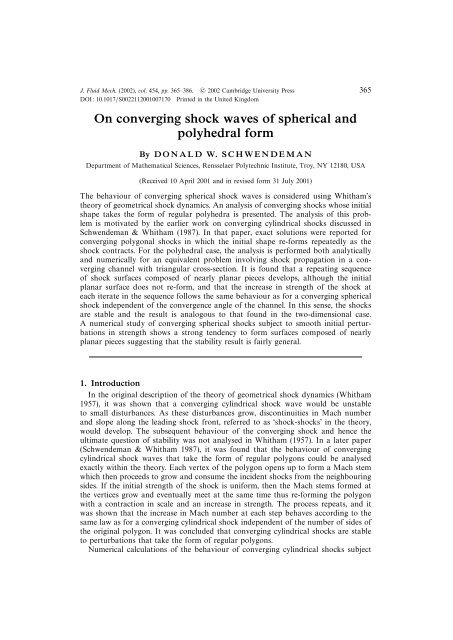
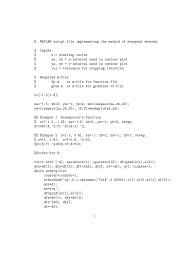

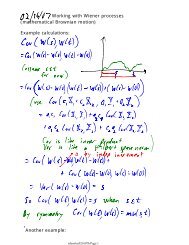

![MATH 1500 Sample Questions Exam 2 1. [3.7] A 10-ft plank is ...](https://img.yumpu.com/43861920/1/190x245/math-1500-sample-questions-exam-2-1-37-a-10-ft-plank-is-.jpg?quality=85)
